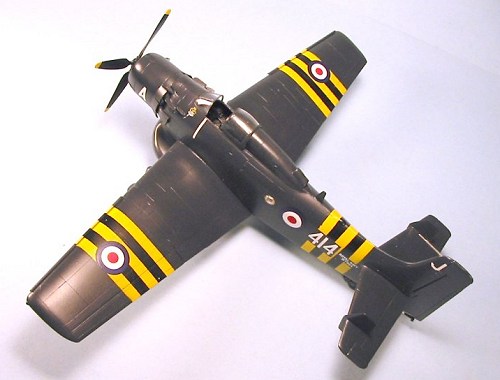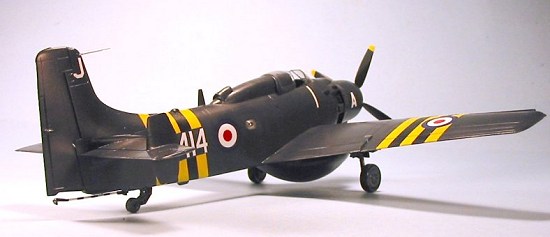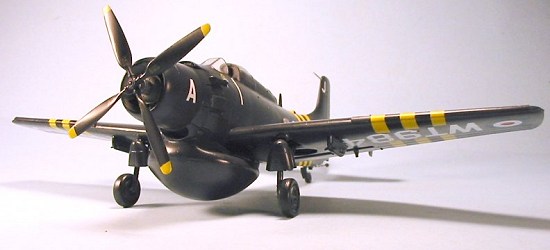
Tamiya/CE 1/48 Skyraider AEW.1
|
KIT # |
? |
|
PRICE: |
$38.00 for the Tamiya kit |
|
DECALS: |
See Review |
|
REVIEWER: |
Tom Cleaver |
|
NOTES: |
Cutting Edge AD-4W conversion used |

|
HISTORY |
One of the lessons the U.S. Navy learned during the Second World War as a result of the Kamikaze campaign was that there was no such thing as too early a warning of an incoming attack. The further away from the fleet the enemy could be detected, the greater the possibility that a sufficient number of fleet defenders could intercept the attackers with enough time to shoot them down before they arrived at the point of attack. Because of the nature of Radar, in that its range is limited by the elevation of the antenna due to the curvature of the earth, the higher the antenna could be located, the greater its range.
The first airborne early warning aircraft was the Grumman TBM-3 Avenger, modified to carry an AN/APS-20 search radar beneath the fuselage an a large radome. Coming just too late to see operational service at the end of the war, the TBM-3W served with the U.S. Navy in the immediate post-war years, before the aircraft were supplied to the French Aeronavale, where they would see operational service during Operation Musketeer in 1956.
 The Douglas
Skyraider, which replaced both the Avenger and the Curtiss Helldiver in
the fleet attack role, was also rapidly developed to replace the airborne
early warning Avenger. The XAD-1W first flew in September 1947. The
primary modification of the airframe was the provision of a compartment
in the fuselage immediately aft of the wing to house two operators for
the AN/APS-20 radar. The radar itself was mounted immediately aft of the
engine between the main landing gear, where it could provide 360-degree
coverage; this also required the oil coolers be moved from their position
immediately below and aft of the engine to a position on the fuselage
sides. Additionally, the early-warning Skyraiders were not fitted with
main landing gear doors as were used on other Skyraiders.
The Douglas
Skyraider, which replaced both the Avenger and the Curtiss Helldiver in
the fleet attack role, was also rapidly developed to replace the airborne
early warning Avenger. The XAD-1W first flew in September 1947. The
primary modification of the airframe was the provision of a compartment
in the fuselage immediately aft of the wing to house two operators for
the AN/APS-20 radar. The radar itself was mounted immediately aft of the
engine between the main landing gear, where it could provide 360-degree
coverage; this also required the oil coolers be moved from their position
immediately below and aft of the engine to a position on the fuselage
sides. Additionally, the early-warning Skyraiders were not fitted with
main landing gear doors as were used on other Skyraiders.
No AD-1Ws were produced, but both the AD-3 and AD-4 sub-types were produced in the early-warning version. Stability and stall problems experienced by the AD-3W and AD-4W led to these aircraft being fitted with a fixed leading edge slat on the outer wing, which improved handling at low speeds during approach and landing.
AD-3W and AD-4W Skyraiders served in two-plane detachments aboard U.S. Navy carriers, beginning in 1949, and provided airborne early warning throughout the Korean War until they wre replaced by the AD-5W in 1954.
In 1952, 50 AD-4W Skyraiders - 20 new-production aircraft and 30 AD-4Ws from US Navy stocks - were provided through the Military Assistance program to the Fleet Air Arm, where they were known as the Skyraider AEW.1. As with the USN, British AEW Skyraiders served in two and three plane detachments aboard Royal Navy carriers, as well as being used from land bases in northern Scotland and the Orkney Islands to provide warning of possible air attacks from the direction of Norway and the Baltic Sea for Britain’s air defense throughout the 1950s.
Aboard ship, the Skyraiders were also used in the Carrier Onboard Delivery (COD) role, and as transportation between carriers at sea.
 The Skyraider
AEW.1 saw operational service with the three British carriers that
participated in Operation Musketeer, the Anglo-French intervention in
Egypt during the 1956 Suez War. Since the Egyptians were unable to mount
effective air attacks on the Anglo-French task force, the Skyraiders
never entered an active combat role.
The Skyraider
AEW.1 saw operational service with the three British carriers that
participated in Operation Musketeer, the Anglo-French intervention in
Egypt during the 1956 Suez War. Since the Egyptians were unable to mount
effective air attacks on the Anglo-French task force, the Skyraiders
never entered an active combat role.
The last AEW.1 Skyraiders departed H.M.S. “Bulwark” in 1960 to be replaced in the AEW role by a modified Fairey Gannet. The AN/APS-20 radars used by the Skyraiders were removed and mounted in RAF Shackletons to provide continued airborne early warning coverage of the northern approaches to the United Kingdom, continuing in this role through the mid-1970s until the final retirement of the Shackletons from RAF service. (Editor's Note: the Shackleton was not retired until 1988-89 and the APS-20 radar is, as far as I know, still being used in VQ-1 and VQ-2s EP-3E Orions despite its vacuum tube design. Your editor can tell many a sea story [with embellishments] about the APS-20...)
Twelve of the AEW.1s, with radars removed, were refurbished by Flight Refuelling Ltd., and sold to Sweden. Painted yellow, the Skyraiders operated as target tugs until they were retired in the early 1980s. One of these Skyraiders was bought by American warbird collector Dave Tallichet and returned to the United States. It can be seen moldering away in Mr. Tallichet’s “back yard” next to the main runways at Chino Airport today, sitting next to a stripped-out and gutted Bristol Bolingbroke Mk.IV.
|
THE KIT |
ESCI released
an AD-4W/AEW.1 Skyraider as part of their series of Skyraiders released
in the early 1980s. The kit differed from the others by provision of the
cockpit extension fairing for the upper fuselage, the different-shaped
canopy, the fixed wing slats, enclosures for the gear well to change the
lower wing to the proper configuration, the two extra
 stabilization fins
that fit to the horizontal stabilizer, and two side panels that provided
the doors with their bubble windows for the radar operators’
compartment. Unfortunately, the ESCI kit itself has major problems in
regards to outline accuracy; this was acceptable until the advent of the
later Tamiya Skyraider, a kit which can be considered “definitive.” The
kit provided decals for a Skyraider operated by the Marines in Korea, and
a Skyraider AEW.1 operated off HMS “Eagle” during the 1956 Suez
intervention, which would also carry the black-and-yellow “invasion
stripes.”
stabilization fins
that fit to the horizontal stabilizer, and two side panels that provided
the doors with their bubble windows for the radar operators’
compartment. Unfortunately, the ESCI kit itself has major problems in
regards to outline accuracy; this was acceptable until the advent of the
later Tamiya Skyraider, a kit which can be considered “definitive.” The
kit provided decals for a Skyraider operated by the Marines in Korea, and
a Skyraider AEW.1 operated off HMS “Eagle” during the 1956 Suez
intervention, which would also carry the black-and-yellow “invasion
stripes.”
Tamiya introduced their A-1H Skyraider in 1998. The kit has replaced both the earlier Monogram and ESCI Skyraider kits on any grounds other than cost. The kit is very accurate in outline and easy to build into a good-looking model. The only thing a modeler needs to worry about is assembling the wing to the fuselage so that the proper dihedral is maintained; this is easily accomplished by use of a rubber band to hold the wing at the correct angle until the glue sets up. Just gluing the wing to the fuselage without doing this will guarantee that the wing sets up without the proper dihedral.
|
CONSTRUCTION |
Since I had an old ESCI kit in the stash, I decided I would turn that into an “aftermarket set” and use the parts for the AD-4W on a Tamiya kit. This project got so far as my cutting out the sides of the Tamiya kit’s fuselage and glueing the side panels from the ESCI kit in position, at which point the project went into “hibernation” for a year or so. When I received a review sample of the Cutting Edge conversion set for the AD-4W tailor-made for the Tamiya kit, I decided to resurrect the project.
 Cutting Edge
provides a beautiful solid-resin radome, resin wing slats, resin oil
coolers, a correct-size canopy to fit the Tamiya kit (the ESCI canopy
being a bit small), the upper fuselage fairing, the additional stability
fins, the correct early underwing bomb and drop tank racks, and a resin
instrument panel fitted with the correct radar repeater. Cutting Edge
expects the modeler to fill in the dive brakes on the side of the
fuselage of the Tamiya kit, and then to scribe the side doors.
Personally, I was glad I had used the ESCI parts, which had to be
rescribed with correct panel lines once I had filled in and gotten rid of
the seams created by cutting open the fuselage.
Cutting Edge
provides a beautiful solid-resin radome, resin wing slats, resin oil
coolers, a correct-size canopy to fit the Tamiya kit (the ESCI canopy
being a bit small), the upper fuselage fairing, the additional stability
fins, the correct early underwing bomb and drop tank racks, and a resin
instrument panel fitted with the correct radar repeater. Cutting Edge
expects the modeler to fill in the dive brakes on the side of the
fuselage of the Tamiya kit, and then to scribe the side doors.
Personally, I was glad I had used the ESCI parts, which had to be
rescribed with correct panel lines once I had filled in and gotten rid of
the seams created by cutting open the fuselage.
Since the AD-4 did not carry the appliqué armor around the cockpit and oil coolers, I used the Dremel to remove that raised plastic area on the fuselage, and then sanded the fuselage smooth with several different sanding sticks. Cutting Edge provides a separate kit of parts to replace these areas, but the truth is those parts are merely pieces of a Tamiya kit that was ground down and sanded smooth, as I did with the kit itself. This is not difficult for anyone with normal hand-eye coordination.
 Other than
fitting the replacement instrument panel in place of the kit panel,
construction of the overall model proceeded according to the
instructions. I filled in the holes on the underwing surface by use of a
.020 plastic rod, inserted, glued in position and cut off, then sanded
down smooth once all the rods had set in position. I also used the resin
plugs for the main gear wells, which needed some Mr. Surfacer applied and
sanded down to get rid of the seams. I needed to do some dremeling to the
resin radome once it was cut away from the molding block to insure a good
fit against the lower wing and fuselage surface. A bit of dremeling was
also necessary with the underwing racks to provide good fit.
Other than
fitting the replacement instrument panel in place of the kit panel,
construction of the overall model proceeded according to the
instructions. I filled in the holes on the underwing surface by use of a
.020 plastic rod, inserted, glued in position and cut off, then sanded
down smooth once all the rods had set in position. I also used the resin
plugs for the main gear wells, which needed some Mr. Surfacer applied and
sanded down to get rid of the seams. I needed to do some dremeling to the
resin radome once it was cut away from the molding block to insure a good
fit against the lower wing and fuselage surface. A bit of dremeling was
also necessary with the underwing racks to provide good fit.
Once the model was assembled, it was time to go to the paint shop.
|
COLORS AND MARKINGS |
Painting:
I pre-shaded the areas where the yellow-and black invasion stripes would go, and painted in the areas for the black stripes. I then masked the black stripes off and applied Tamiya Flat Yellow for the other stripes; by applying lighter paint over darker paint, the end result was stripes that looked temporary in their application.
 The model was
painted overall with Gunze-Sangyo “Midnight Blue.” This included the
landing gear and wheel hubs. When that was dry, I unmasked the stripes
and gave the model a coat of Future.
The model was
painted overall with Gunze-Sangyo “Midnight Blue.” This included the
landing gear and wheel hubs. When that was dry, I unmasked the stripes
and gave the model a coat of Future.
Decals:
I found that the ESCI kit decals were too old to use when they fell apart in the water. A quick post at HyperScale put me in touch with a modeler who not only had the sheet, but had a later-production kit with Scalemaster decals, which were a vast improvement on the early decals I had, since the national insignia were both the proper colors and the proper sizes and layouts, and the white decals were sufficiently opaque enough to go over a dark surface successfully. These decals were also not matte, as the earlier ones were, which meant it was not so hard after they had set up to get them to take a coat of Future and give the surface of the model a uniform appearance.
|
FINAL CONSTRUCTION |
I unmasked the canopy and door windows, and attached the wheels, prop, tailwheel and tail hook. The few photos I had of British Skyraiders showed they were well-maintained, and that the Glossy Sea Blue had not weathered much by the time of the 1956 Suez Intervention, so I left the model clean.
|
CONCLUSIONS |
The Skyraider AEW.1 “Guppy” is an ungainly-looking aircraft whose performance belied its looks. The airplane was almost as maneuverable as the single-seater, and just as reliable as all the other Skyraiders. Its role may have been unsung, but it would have been of crucial importance had the “balloon gone up” during its period of service. Addition of this model fills in an important hole in my Operation Musketeer collection.
April 2004
Kit courtesy of my wallet.
Copyright ModelingMadness.com. All rights reserved. No reproduction in any form without express permission from the editor.
If you would like your product reviewed fairly and quickly, pleasecontact the editor or see other details in the Note to Contributors.